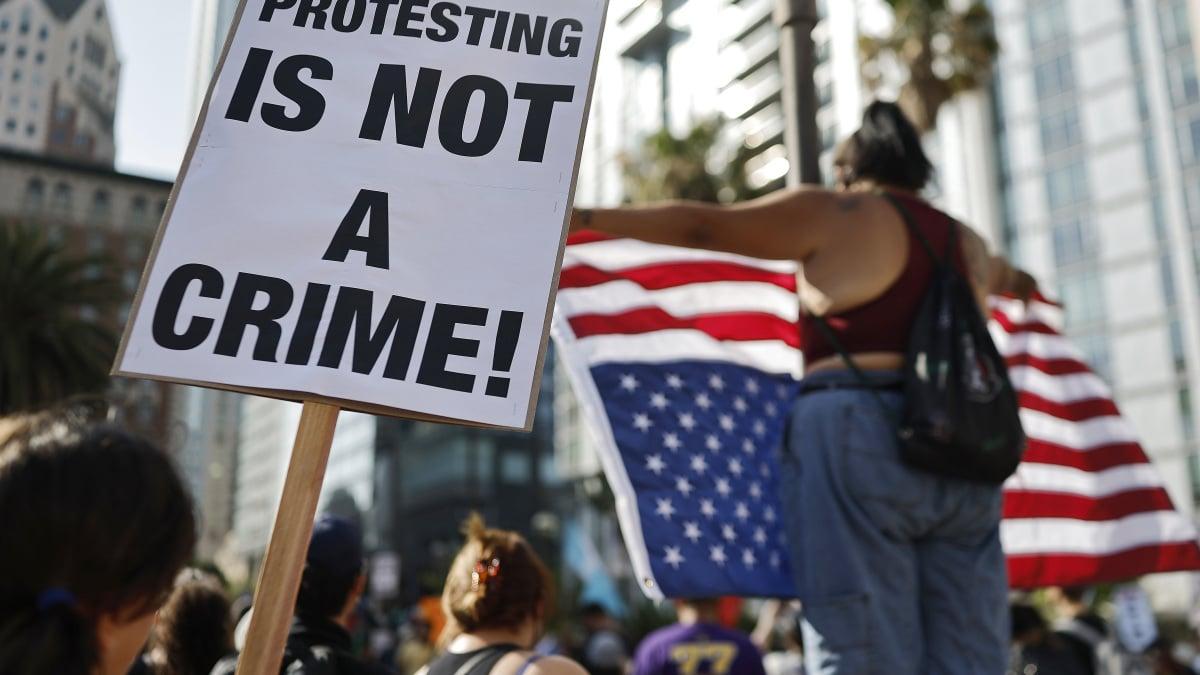Following days of protest decrying the actions of Immigration and Customs Enforcement (ICE) and militarized federal forces in Los Angeles, downtown L.A. residents remained under curfew this week while California governor Gavin Newsom went toe-to-toe with President Trump, who sent Marines into the area. Memes, and viral misinformation, were abundant.
Meanwhile, the "No Kings" organizing coalition has planned thousands more peaceful demonstrations this weekend, specifically orchestrated to overlap with Trump's planned military parade. While the organizations behind the events are gearing up for what they've said will be the "largest single-day, peaceful protest" in the country's history, some worry they may be met with an equal show of state-sanctioned violence — and attempts to undermine news coverage via viral falsehoods.
Peter Adams, senior vice president of research and design for the News Literacy Project, explained that mass demonstrations are rife for online misinformation, patterns which can be spotted before protesters even touch ground. Adams runs the organization's online misinformation newsletter RumorGuard, which collates viral fact-checks and critical literacy tips.
"Protests generally only happen around events that are highly polarizing and controversial," said Adams. "The more polarizing something is, the more people's political identities are activated and invoked. We know that these identities play a very strong role in how people react to information online. As polarization has increased in American society, this is even more at play."
News and misinformation debunking organizations, such as bipartisan NewsGuard, have reputed dozens of false posts, including those made by conservative commentators alleging Newsom had posted an outdated or AI-generated photo of national guard troops as he criticized Trump's militarized protest response. Such posts were propelled by X chatbot Grok, which told some users that the photos, first published by the San Francisco Chronicle, were outdated — ChatGPT users got similarly confusing responses.
Others, including representatives of the Trump administration, fanned the flames with misattributed or outrightly false quotes from federal and international leaders, including California congresswoman Maxine Waters and Mexican president Claudia Scheinbaum. Viral posts from partisan voices on both sides of the conflict have attempted to sway, or overtly manipulate, public perception and recast reality in terms that are more favorable to their side, Adams explains.
"Viral misinformation expresses patterns over time, and we can learn how to recognize those patterns and inoculate ourselves to a whole swath of viral rumors," explained Adams.
As protests continue, here's what to look out for:
Mashable Light Speed
AI chatbot errors and hallucinations
"Chatbots often generate outdated or inaccurate details, and that can be especially true during fast-moving events," explained Adams and other News Literacy Project experts. While users are turning to built-in chatbots to fact-check on platforms that have removed internal fact-checking programs, AI-powered assistants are increasingly unreliable sources for news.
Despite its convenience, "AI is really prone to making big errors, and to integrating details from low quality sources alongside high quality sources, sanitizing them and presenting falsehoods alongside facts that makes it harder for people to parse," said Adams. "Don't turn to generative AI to ask whether something is true and take it at its word."
The paid protestor myth
Nearly every mass demonstration is met with accusations that at least some of its participants were hired to be on the ground, according to the News Literacy Project. On June 10, for example, a fake Craigslist ad circulated on social media claiming to seek “the toughest badasses in the city” for a $6,500 to $12,500 payout to attend the L.A. demonstrations.
Online pranks or "troll" behavior may exacerbate the spread of such rumors. It's easier than ever to fake a screenshot from a user or official accounts, said Adams, and the fact that many public officials and agencies have started to lean into ironic posting only exacerbates public confusion about which posts are authentic.
Bricks and other objects used for 'violent' protest
Allegations that protestors have staged piles of bricks or other objects ahead of time to help violent protestors is a "recurring hoax" surrounding mass demonstrations, the organization explains.
During last week's protests, which led to combative encounters with police and the destruction of property, some online alleged the effort was organized, including placing bricks in strategic areas; the posts misleadingly included images from construction projects in New Jersey and Malaysia.
Recycled footage of looting, arson, or previous protests
Coverage of mass protests is also frequently drowned out by unrelated footage circulated online for virality or to inflame a specific response to the events (the same is often true during severe weather disasters). Videos from the wave of protests following the 2020 murder of George Floyd, for example, made the rounds following the Los Angeles demonstrations on June 8.
"Sharing out-of-context footage is one of the most common tricks used to spread falsehoods," said the organization.
Video game or movie clips passed off as the real thing
More recently, hyperrealistic footage from video games have been shared as real world events and news. Generative AI may also complicate an individual's ability to discern reality from fiction.
Individuals may fall victim to fake or ironic posts mistakenly shared as real news, or what Adams calls a "stolen satire" phenomenon, as brands and online trolls take advantage of a confusing information environment. Generally, the rise of news influencers, live streamers, and people claiming to be "citizen journalists"— now more frequently on the ground at protests — feed into ongoing partisan attempts to discredit the intent and veracity of standards-based news sources, says Adams.
"We get into a territory where no one can agree what is real, and that is an environment in which democracy cannot flourish," he said. "Be aware of your emotions. Be wary of user-generated content and unknown sources. Always stop and verify you're not amplifying anything you're not confident is true."






